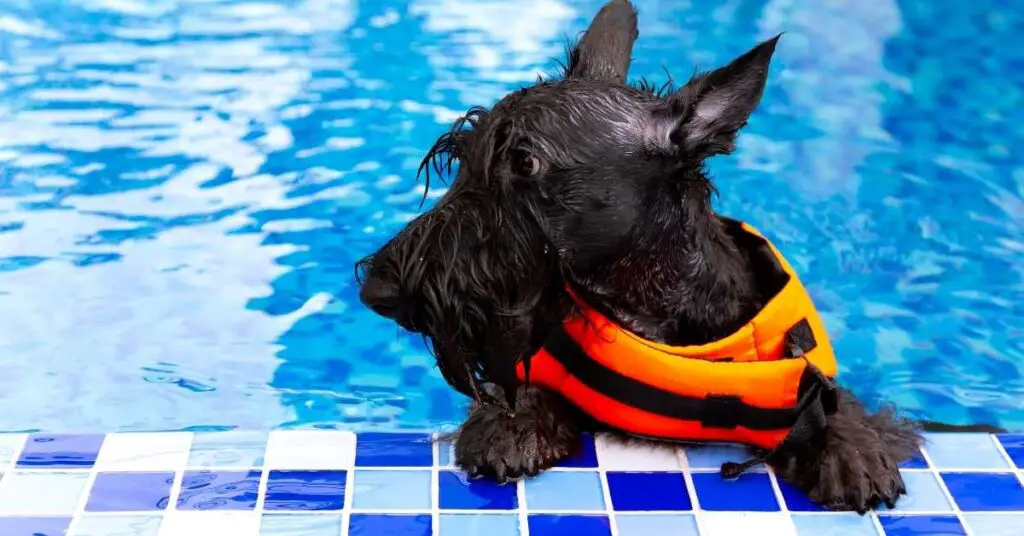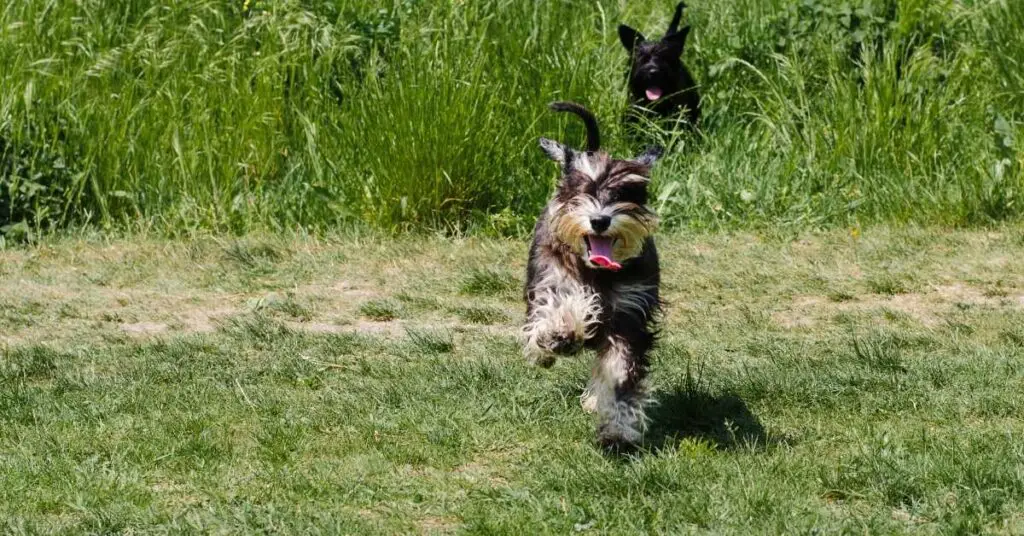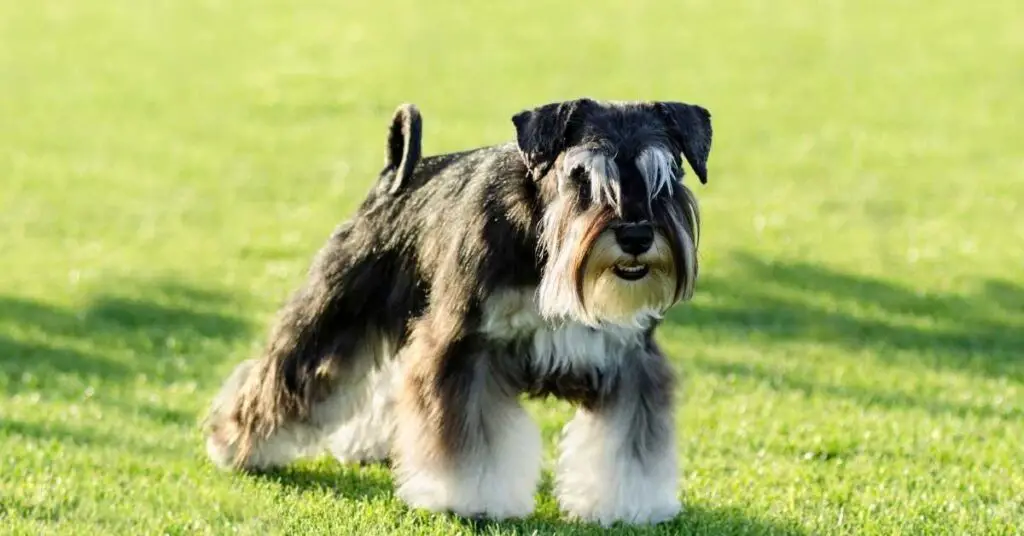Do you ever wonder if your adorable schnauzer will get along with other dogs? Well, you’re not alone! Many dog owners, like yourself, desire a sense of belonging and want their furry friends to have positive interactions with other canines.
It’s important to consider the temperament and socialization of schnauzers when it comes to their compatibility with other dogs. By understanding their pack dynamics and following proper introduction techniques, you can create a harmonious dog-to-dog interaction.
In this article, we will explore the topic of schnauzers getting along with other dogs, including common challenges and training tips. So let’s dive in and uncover the joy of canine camaraderie for your schnauzer!
Schnauzer Temperament: Friendly or Aggressive
Schnauzer temperament can vary, but they generally exhibit a friendly disposition towards other dogs. These furry companions have a unique behavior that can be described as assertive yet submissive.
Schnauzers are known for their strong-willed nature and confidence, which can sometimes come across as assertiveness. However, when it comes to interacting with other dogs, they tend to be more submissive and open to learning from their furry peers.
Schnauzers possess excellent social skills and easily adapt to different play styles and personalities. They’ve a natural ability to read and understand other dogs’ body language and adjust their behavior accordingly. This allows them to form positive relationships and create a harmonious environment when interacting with other dogs.

Socialization: Key to a Peaceful Coexistence
To ensure a peaceful coexistence between your Schnauzer and other dogs, socialization is key. Early socialization plays a crucial role in shaping your Schnauzer’s behavior and temperament towards other dogs. By exposing your Schnauzer to different social environments and interactions with other dogs from a young age, you can help them develop the necessary skills to navigate social situations confidently.
There are several benefits of early socialization for Schnauzers. It helps them become more comfortable and less fearful around other dogs, reducing the likelihood of aggressive or anxious behavior. Socialization also teaches them proper doggy manners, such as how to communicate and play appropriately with other dogs.
When introducing your Schnauzer to different social environments, start with controlled and positive experiences. Gradually expose them to new dogs, places, and situations, ensuring they’ve pleasant interactions. Supervise their interactions closely and reward them for good behavior. This will help build their confidence and establish positive associations with other dogs.
Understanding Schnauzer Pack Dynamics
Understanding the dynamics of a Schnauzer pack can provide insight into their behavior and interactions with other dogs.
Schnauzers, like many other dog breeds, have a hierarchical structure within their pack. This hierarchy helps establish social order and maintain balance within the group.
In a Schnauzer pack, there’s usually an alpha dog who holds the highest rank and is responsible for making decisions for the group. Other dogs in the pack will have their own place in the hierarchy, with each dog understanding their rank and role.
It’s important for Schnauzer owners to be aware of this pack dynamic and to establish themselves as the pack leader to ensure a harmonious relationship with their Schnauzer and other dogs they may encounter.
Introducing a New Dog to Your Schnauzer
When introducing a new dog to your Schnauzer, it’s important to establish clear boundaries and ensure a smooth transition. Here are some tips for introducing a new puppy to your Schnauzer.
- First, choose a neutral location for the introduction, such as a park or a backyard, to avoid territorial issues.
- Keep both dogs on a leash initially, allowing them to sniff and interact while keeping control.
- Gradually increase their time together, always monitoring their behavior for signs of aggression or discomfort.
- Provide separate spaces for each dog to retreat to, ensuring they have their own toys and beds.
Additionally, avoid common mistakes when introducing a new dog to your Schnauzer, such as forcing interactions or neglecting to give each dog individual attention.
Common Challenges When Introducing Schnauzers to Other Dogs
One common challenge when introducing Schnauzers to other dogs is ensuring a proper understanding of boundaries and establishing a harmonious dynamic.
Schnauzers, like any other breed, may face socialization challenges when introduced to new environments. It’s important to approach these introductions with caution and patience, as every dog has its own personality and temperament.
Schnauzers can be territorial, so it’s crucial to set clear boundaries and supervise interactions to prevent any potential conflicts. Gradual introductions, starting with neutral spaces and controlled environments, can help ease the process.
Proper socialization and training from an early age can also contribute to better interactions with other dogs. Remember, each dog is unique, and it may take time and effort to achieve a successful integration.
Training Tips for a Harmonious Dog-to-Dog Interaction
To ensure a harmonious dog-to-dog interaction, it’s important to focus on training and establishing clear communication between your Schnauzer and other dogs. Effective dog training techniques can help prevent and manage dog-to-dog aggression, ensuring a safe and pleasant experience for everyone involved.
Start by teaching your Schnauzer basic obedience commands, such as sit, stay, and come. These commands will help you maintain control and redirect your dog’s attention when needed. Additionally, socializing your Schnauzer from an early age is crucial. Gradually expose them to different dogs and environments, rewarding calm and appropriate behavior.
Use positive reinforcement techniques, such as treats and praise, to encourage good behavior and discourage aggression. Remember to always supervise interactions between your Schnauzer and other dogs, and intervene if necessary.
With patience, consistency, and proper training, your Schnauzer can learn to have positive and harmonious interactions with other dogs.
Schnauzer Breed Compatibility: Which Breeds Get Along Best
The top three breeds that get along best with Schnauzers are the Cavalier King Charles Spaniel, the Bichon Frise, and the Boston Terrier. These breeds have been found to have good compatibility with Schnauzers in terms of temperament and energy levels.
The Cavalier King Charles Spaniel is known for its friendly and gentle nature, making it a great companion for Schnauzers.
The Bichon Frise is a small breed that’s also known for being friendly and sociable, which can help in creating a harmonious relationship with Schnauzers.
The Boston Terrier, although slightly larger than the other two breeds, is known for its friendly and outgoing personality, making it a good match for Schnauzers.
When introducing Schnauzers to small breeds, it’s important to supervise the initial interactions and gradually introduce them in a controlled environment to ensure a positive and successful introduction.
Signs of Aggression in Schnauzers: What to Watch Out For
Watch out for these signs of aggression in Schnauzers:
- Growling and Barking: If your Schnauzer starts growling or barking excessively, especially in response to certain triggers, it could be a sign of aggression. Pay attention to their body language, as raised hackles, a stiff stance, and a fixed gaze may accompany these vocalizations.
- Snapping or Lunging: Aggressive Schnauzers may exhibit snapping or lunging behavior towards other dogs or humans. This can be a warning sign that they feel threatened or uncomfortable in a particular situation. It’s important to address this behavior promptly to prevent any harm.
- Possessiveness: Schnauzers with aggression issues may become possessive over toys, food, or other resources. They may guard these items, growl, or even snap if someone or another animal approaches.
Managing aggression in Schnauzers involves understanding the triggers that provoke their aggressive behavior and addressing them through training, socialization, and positive reinforcement techniques. It’s crucial to consult with a professional dog trainer or behaviorist to develop a tailored plan for your Schnauzer’s specific needs.
Conclusion: Schnauzers and the Joy of Canine Camaraderie
How can Schnauzers experience the joy of canine camaraderie with other dogs?
Schnauzer socialization is the key to fostering positive relationships with other dogs. By exposing your Schnauzer to different dogs and environments from an early age, you can help them develop good social skills and build confidence.
Regular playdates, visits to dog parks, and enrolling in obedience classes are all great ways to introduce your Schnauzer to other dogs.
The benefits of dog companionship are numerous. Dogs are pack animals by nature, and having a furry friend can provide your Schnauzer with companionship, mental stimulation, and emotional support. Additionally, interacting with other dogs can help alleviate boredom and prevent destructive behavior.
Frequently Asked Questions
What Are Some Common Challenges When Introducing Schnauzers to Other Dogs?
When introducing schnauzers to other dogs, common challenges may arise. It is important to train your schnauzer for harmonious interactions. Start slowly, use positive reinforcement, and supervise their initial meetings to ensure a smooth introduction.
How Can I Train My Schnauzer to Have a Harmonious Interaction With Other Dogs?
To train your schnauzer to have a harmonious interaction with other dogs, use positive reinforcement training methods and socialization techniques. Introduce your dog to different dogs gradually, rewarding good behavior and addressing any issues that arise.
Are There Any Specific Breeds That Schnauzers Get Along Best With?
When introducing your schnauzer to other dogs, it’s important to consider their individual temperament. While there may be misconceptions about compatibility with specific breeds, focus on positive, supervised interactions to foster a harmonious relationship.
What Are Some Signs of Aggression That I Should Watch Out for in My Schnauzer?
Watch out for signs of aggression in your schnauzer, such as growling, snapping, or lunging. If you notice these behaviors, address them immediately with positive reinforcement training and professional help if needed.
Can You Give Any Additional Tips or Advice for Maintaining a Peaceful Coexistence Between Schnauzers and Other Dogs?
To maintain a peaceful coexistence between schnauzers and other dogs, follow these tips: 1) Introduce them gradually in a neutral space. 2) Observe body language and address signs of aggression promptly. 3) Provide positive reinforcement for good behavior. 4) Seek professional help if needed.
Conclusion
In conclusion, schnauzers can get along well with other dogs if properly socialized and trained. It’s important to understand their temperament and pack dynamics to ensure a peaceful coexistence.
Introducing a new dog to your schnauzer should be done gradually and with careful supervision. Training tips can help promote harmonious dog-to-dog interactions. While schnauzers can generally get along with other breeds, it’s important to watch for signs of aggression.
Overall, with proper care and attention, schnauzers can experience the joy of canine camaraderie.






